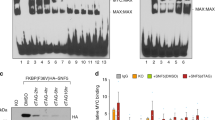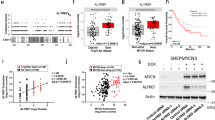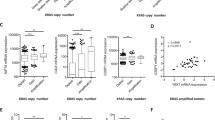Abstract
USF is a family of transcription factors that are structurally related to the Myc oncoproteins and also share with Myc a common DNA-binding specificity. USF overexpression can prevent c-Myc-dependent cellular transformation and also inhibit the proliferation of certain transformed cells. These antiproliferative activities suggest that USF inactivation could be implicated in carcinogenesis. To explore this possibility, we compared the activities of the ubiquitous USF1 and USF2 proteins in several cell lines derived from either normal breast epithelium or breast tumors. The DNA-binding activities of USF1 and USF2 were present at similar levels in all cell lines. In the non-tumorigenic MCF-10A cells, USF in general, and USF2 in particular, exhibited strong transcriptional activities. In contrast, USF1 and USF2 were completely inactive in three out of six transformed breast cell lines investigated, while the other three transformed cell lines exhibited loss of USF2 activity. Analyses in cells cultured from healthy tissue confirmed the transcriptional activity of USF in normal human mammary epithelial cells. These results demonstrate that a partial or complete loss of USF function is a common event in breast cancer cell lines, perhaps because, like Myc overexpression, it favors rapid proliferation.
This is a preview of subscription content, access via your institution
Access options
Subscribe to this journal
Receive 50 print issues and online access
$259.00 per year
only $5.18 per issue
Buy this article
- Purchase on Springer Link
- Instant access to full article PDF
Prices may be subject to local taxes which are calculated during checkout








Similar content being viewed by others
References
Beckmann H, Su LK and Kadesch T. . 1990 Genes Dev. 4: 167–179.
Bendall AS and Molloy PL. . 1994 Nucleic Acids Res. 22: 2801–2810.
Blackwell TK, Kretzner L, Blackwood EM, Weintraub H and Eisenman RN. . 1990 Science 250: 1149–1151.
Escot C, Simony-Lafontaine J, Maudelonde T, Puech C, Pujol H and Rochefort H. . 1993 Oncogene 8: 969–974.
Fischer DE, Carr CS, Parent LA and Sharp PA. . 1991 Genes Dev. 5: 2342–2352.
Garte SJ. . 1993 Crit. Rev. Oncogen. 4: 435–448.
Gregor PD, Sawadogo M and Roeder RG. . 1990 Genes Dev. 4: 1730–1740.
Kerkhoff E, Bister K and Klempnauer KH. . 1991 Proc. Natl. Acad. Sci. USA 88: 4323–4327.
Kern SE, Pietenpol JA, Thiagalingam S, Seymour A, Kinzler KW and Vogelstein B. . 1992 Science 256: 827–830.
Kreipe H, Feist H, Fisher L, Felgner J, Heidorn K, Mettler L and Parwaresch R. . 1993 Cancer Res. 53: 1956–1961.
Krief P, Saint-Ruf C, Bracke M, Boucheix C, Billard M, Cassingena R, Jasmin C, Mareel M and Assorone B. . 1989 Int. J. Cancer 43: 658–664.
Krylov D, Kasai K, Echlin DR, Taparowsky EJ, Arnheiter H and Vinson C. . 1997 Proc. Natl. Acad. Sci. USA 94: 12274–12279.
Land H, Parada LF and Weinberg RA. . 1983 Nature 304: 596–602.
Luo X and Sawadogo M. . 1996a Proc. Natl. Acad. Sci. USA 93: 1308–1313.
Luo X and Sawadogo M. . 1996b Mol. Cell. Biol. 16: 1367–1375.
Marcu KB, Bossone SA and Patel AJ. . 1992 Annu. Rev. Biochem. 61: 809–860.
Meier JL, Luo X, Sawadogo M and Straus SE. . 1994 Mol. Cell. Biol. 14: 6896–6906.
Murre C, McCaw PS and Baltimore D. . 1989 Cell 56: 777–783.
Qyang Y, Luo X, Lu T, Ismail P, Krylov D, Vinson C and Sawadogo M. . 1999 Mol. Cell. Biol. 19: 1508–1517.
Roux-Dosseto M, Romain S, Dussault N, Desideri C, Piana L, Bonnier P, Tubiana N and Martin PM. . 1993 Eur. J. Cancer 28A: 1600–1604.
Roy AL, Du H, Gregor PD, Novina CD, Martinez E and Roeder RG. . 1997 EMBO J. 16: 7091–7104.
Sadowski I, Ma J, Triezenberg S and Ptashne M. . 1988 Nature 335: 563–564.
Sawadogo M and Roeder RG. . 1985 Cell 43: 165–175.
Schreiber E, Matthias P, Muhler MM and Schaffner W. . 1989 Nucleic Acids Res. 17: 6419.
Sirito M, Lin Q, Deng JM, Behringer RR and Sawadogo M. . 1998 Proc. Natl. Acad. Sci. USA 95: 3758–3763.
Sirito M, Lin Q, Maity T and Sawadogo M. . 1994 Nucleic Acids Res. 22: 427–433.
Soule HD, Maloney TM, Wolman SR, Peterson Jr WD, Brenz R, McGrath CM, Russo J, Pauley RJ, Jones RF and Brooks SC. . 1990 Cancer Res. 50: 6075–6086.
Vallet VS, Casado M, Henrion AA, Bucchini D, Raymondjean M, Kahn A and Vaulont S. . 1998 J. Biol. Chem. 273: 20175–20179.
Varley MJ, Swallow JE, Brammar WJ, Whittaker JL and Walker RA. . 1987 Oncogene 1: 423–430.
Viollet B, Lefrancois-Martinez AM, Henrion A, Kahn A, Raymondjean M and Martinez A. . 1996 J. Biol. Chem. 271: 1405–1415.
Wood WM, Kao MY, Gordon DF and Ridgway EC. . 1989 J. Biol. Chem. 264: 14840–14847.
Acknowledgements
We thank M-C Hung, D-H Yu and K Galaktionov for cell lines, X Luo, S Maity and G Lozano for plasmids, H-X Yang for technical assistance, and MN Szentirmay for critical reading of the manuscript. This work was supported by Grants DAMD17-96-1-6221 from the Department of the Army and CA79578 from the National Cancer Institute (MS), by institutional funds, and by a postdoctoral fellowship from the National Cancer Institute Training Grant CA09299 (T Lu).
Author information
Authors and Affiliations
Rights and permissions
About this article
Cite this article
Ismail, P., Lu, T. & Sawadogo, M. Loss of USF transcriptional activity in breast cancer cell lines. Oncogene 18, 5582–5591 (1999). https://doi.org/10.1038/sj.onc.1202932
Received:
Revised:
Accepted:
Published:
Issue Date:
DOI: https://doi.org/10.1038/sj.onc.1202932
Keywords
This article is cited by
-
PretiMeth: precise prediction models for DNA methylation based on single methylation mark
BMC Genomics (2020)
-
Regulatory network changes between cell lines and their tissues of origin
BMC Genomics (2017)
-
Integrative analysis of mutational and transcriptional profiles reveals driver mutations of metastatic breast cancers
Cell Discovery (2016)
-
Expressions of heparanase and upstream stimulatory factor in hepatocellular carcinoma
European Journal of Medical Research (2014)
-
Regulation of CEACAM1 transcription in human breast epithelial cells
BMC Molecular Biology (2010)



